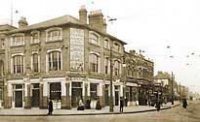Принцесса Элис - 1878 год...
Затопление прогулочного катера, набитого пассажирами, возвращавшимися с прогулки, было бы трагедией, где бы это ни произошло. Случайное событие, превратило аварию в катастрофу. Чтобы понять и почувствовать, мы должны вернуться в прошлое.
Река Темза всегда снабжала лондонцев питьевой водой и была важной транспортной артерией. Лондонцы отплатили ей тем, что превратили реку в гигантскую канализацию. Сбрасывая в нее весь мусор, нечистоты, падаль... они надеялись, что река унесет стоки вниз и в море. Все было очень хорошо, пока население не выросло и объем сточных вод не превысил сток речной воды. Когда запах стал настолько сильным, что парламент и суды были вынуждены приостановить заседания, они решили что-то с этим сделать. Решение состояло в том, чтобы построить канализацию, чтобы отвести воду вниз по реке за пределы центра Лондона. Неочищенные сточные воды сбрасывались в Темзу на повороте реки недалеко от Баркинга в Восточном Лондоне.
3 сентября 1878 года угольщик под названием «Замок Байуэлл» столкнулся с небольшой легкой прогулочной лодкой, набитой отдыхающими, и результат мог быть только один - «Принцесса Алиса» затонула, погрузив команду и всех пассажиров в воду в том самом месте, где канализация сбрасывала свое отвратительное содержимое в реку. До берега было всего 300 ярдов, но мало кто умел плавать.
Выжившим пришлось цепляться за все, что плавало, пока они боролись с берегом через сильно загрязненную воду. Как впоследствии заметил один из лодочников-спасателей, «они не столько плавали, сколько совершали движения».
«Принцесса Алиса» имела лицензию на перевозку 1000 пассажиров, но неизвестно, сколько их было на борту в тот роковой день. В последующие дни было извлечено около 640 тел, в том числе множество женщин, детей и младенцев, но нет информации о количестве выживших, которые скончались позже из-за последствий. Следствие было встревожено, чтобы выяснить уровень загрязнения и его последствия для здоровья. Богатые районы Лондона решили свою проблему, передав ее бедным районам Восточного Лондона. Были предприняты шаги по установке очистных сооружений для очистки сточных вод перед их сбросом в реку.
 Паб был назван «Принцесса Алиса» в память о погибших в трагедии. Он стоял на пересечении Ромфорд-роуд и Вудгрейндж-роуд, пока не был разрушен бомбой во время самого крупного налета на Лондон во время Блица. После войны паб был перестроен и, в отличие от многих старых пабов Лондона, сохранил свое название.
Паб был назван «Принцесса Алиса» в память о погибших в трагедии. Он стоял на пересечении Ромфорд-роуд и Вудгрейндж-роуд, пока не был разрушен бомбой во время самого крупного налета на Лондон во время Блица. После войны паб был перестроен и, в отличие от многих старых пабов Лондона, сохранил свое название.
The sinking of a pleasure boat filled with passengers returning from a day out would have been a tragedy wherever it happened. For it to go down where it did turned an accident into a disaster. To understand why we have to go back in time.
The river Thames has always provided Londoners with drinking water and a vital means of transport. They repaid the debt by turning it into a giant sewer. Discharging all their foul water and rubbish into it they hoped that the river would carry the effluent down and out to the sea. This was all very well until the population grew and the volume of the sewage exceeded the flow of river water. When the smell became so overpower that Parliament and the Law Courts were forced to suspend sittings they decided to do something about it. The solution was to build sewers to take the water down river beyond central London. The untreated sewerage was discharged into the Thames at the turn of the river just off Barking in East London.
On September 3, 1878 a collier named the 'Bywell Castle' collided with a small, light pleasure boat crowded with holidaymakers and there could only be one result. The 'Princess Alice' sank plunging the crew and all the passengers into the water at the very spot where the sewer discharged its foul contents into the river. It was only 300 yards to the shore but not many people could swim. The survivors had to clutch on anything that floated as they struggled to the shore through the heavily contaminated water. As one of the rescuing boatmen remarked afterwards "they were not so much swimming as going through the motions".
The Princess Alice was licensed to hold 1,000 passengers but its is not known how many were on board that fatal day. Around 640 bodies including many women, children and babies were recovered in the following days but there is no information on the number of survivors that succumbed later due to the after effects. The inquiry was alarmed to find out the level of contamination and its consequences on health. The affluent areas of London had cured their problem by passing it on to the poorer areas of East London. Steps were taken to provide sewerage plants to treat the effluent before it was discharged into the river.
A pub was named the Princess Alice in memory of those that lost their lives in the tragedy. It stood on the junction of the Romford Road and Woodgrange Road until it was demolished by a bomb on what was the heaviest raid on London during the Blitz. After the war the pub was rebuilt and unlike many old pubs in London has managed to keep its name.
Видеорегистратор TEXET DVR-546FHD - прмер работы